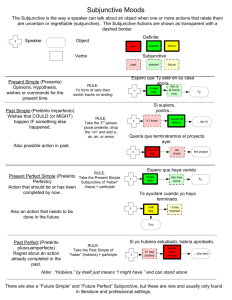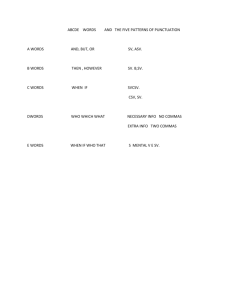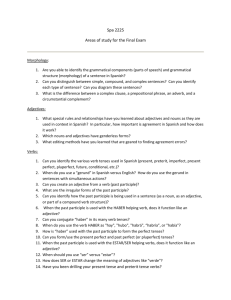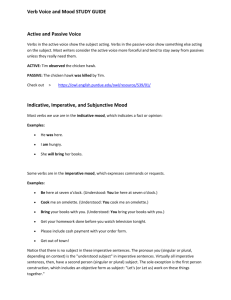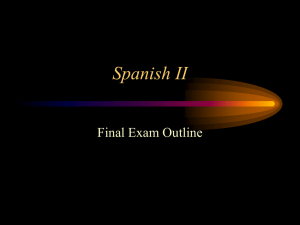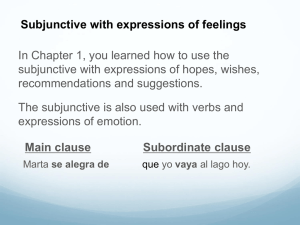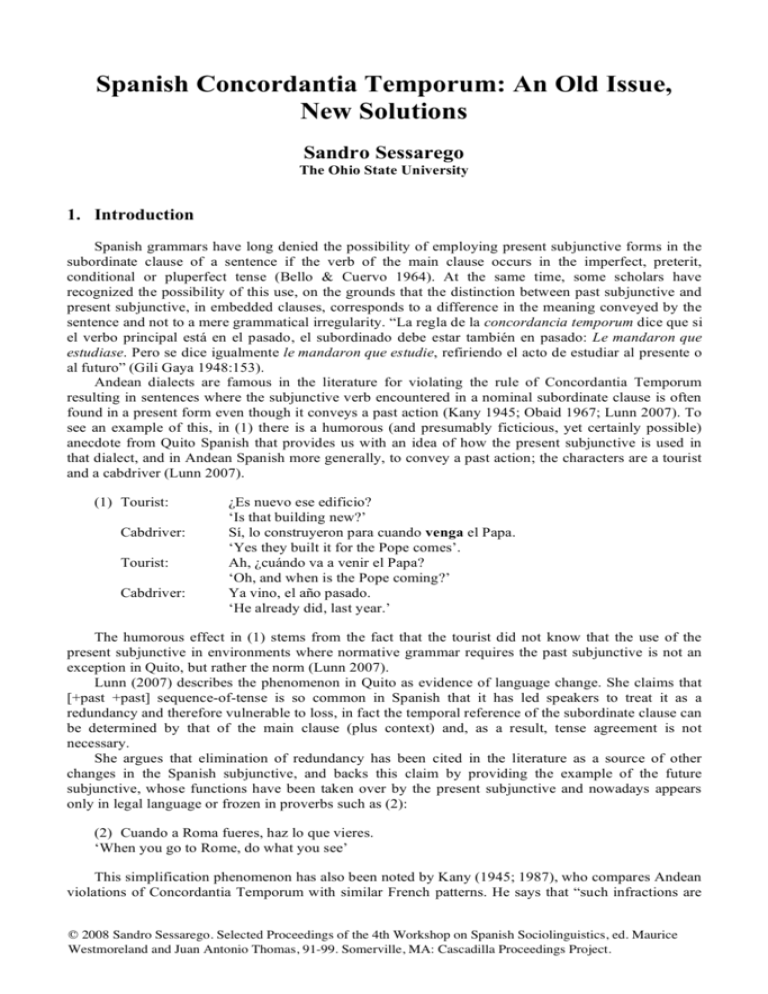
Spanish Concordantia Temporum: An Old Issue,
New Solutions
Sandro Sessarego
The Ohio State University
1. Introduction
Spanish grammars have long denied the possibility of employing present subjunctive forms in the
subordinate clause of a sentence if the verb of the main clause occurs in the imperfect, preterit,
conditional or pluperfect tense (Bello & Cuervo 1964). At the same time, some scholars have
recognized the possibility of this use, on the grounds that the distinction between past subjunctive and
present subjunctive, in embedded clauses, corresponds to a difference in the meaning conveyed by the
sentence and not to a mere grammatical irregularity. “La regla de la concordancia temporum dice que si
el verbo principal está en el pasado, el subordinado debe estar también en pasado: Le mandaron que
estudiase. Pero se dice igualmente le mandaron que estudie, refiriendo el acto de estudiar al presente o
al futuro” (Gili Gaya 1948:153).
Andean dialects are famous in the literature for violating the rule of Concordantia Temporum
resulting in sentences where the subjunctive verb encountered in a nominal subordinate clause is often
found in a present form even though it conveys a past action (Kany 1945; Obaid 1967; Lunn 2007). To
see an example of this, in (1) there is a humorous (and presumably ficticious, yet certainly possible)
anecdote from Quito Spanish that provides us with an idea of how the present subjunctive is used in
that dialect, and in Andean Spanish more generally, to convey a past action; the characters are a tourist
and a cabdriver (Lunn 2007).
(1) Tourist:
Cabdriver:
Tourist:
Cabdriver:
¿Es nuevo ese edificio?
‘Is that building new?’
Sí, lo construyeron para cuando venga el Papa.
‘Yes they built it for the Pope comes’.
Ah, ¿cuándo va a venir el Papa?
‘Oh, and when is the Pope coming?’
Ya vino, el año pasado.
‘He already did, last year.’
The humorous effect in (1) stems from the fact that the tourist did not know that the use of the
present subjunctive in environments where normative grammar requires the past subjunctive is not an
exception in Quito, but rather the norm (Lunn 2007).
Lunn (2007) describes the phenomenon in Quito as evidence of language change. She claims that
[+past +past] sequence-of-tense is so common in Spanish that it has led speakers to treat it as a
redundancy and therefore vulnerable to loss, in fact the temporal reference of the subordinate clause can
be determined by that of the main clause (plus context) and, as a result, tense agreement is not
necessary.
She argues that elimination of redundancy has been cited in the literature as a source of other
changes in the Spanish subjunctive, and backs this claim by providing the example of the future
subjunctive, whose functions have been taken over by the present subjunctive and nowadays appears
only in legal language or frozen in proverbs such as (2):
(2) Cuando a Roma fueres, haz lo que vieres.
‘When you go to Rome, do what you see’
This simplification phenomenon has also been noted by Kany (1945; 1987), who compares Andean
violations of Concordantia Temporum with similar French patterns. He says that “such infractions are
© 2008 Sandro Sessarego. Selected Proceedings of the 4th Workshop on Spanish Sociolinguistics, ed. Maurice
Westmoreland and Juan Antonio Thomas, 91-99. Somerville, MA: Cascadilla Proceedings Project.
92
naturally commoner in speech than in writing and may be heard in the conversation of cultured persons.
The process has here a parallel in spoken French, where all the forms of the past subjunctive have been
lost” (1987:181).
Following Bull (1965), Otero (1974) and Suñer & Padilla-Rivera (1987), I consider that the
present, present perfect, future and future perfect verb forms belong to the “present set”, and can be
represented as [-past], while the imperfect, preterit, past perfect, conditional and conditional perfect are
members of the “past set” [+past].
Suñer & Padilla-Rivera (1987) observe that the tense sequence [+ past … - past] is allowed pandialectally, as in the following examples.
(3) El agricultor dijo que era una lástima que aún no se cultive maíz en esa zona.
(4) El médico recomendó que la niña no coma tantos productos lácteos.
The authors affirm that “the sequencing in […] the examples is used to report a past event
(expressed by the main verb), which has consequences for other events, which are yet to take place
(expressed by the present subjunctive)” (1987:639).
Farley (1970) claims that violations of Concordantia Temporum are present in both Latin
American and Peninsular Spanish. He provides the following examples to support his position:
(5) “U. Thant declaró … que había fracasado en su intento de convencer a Kruchef de que Rusia
pague los 52 millones de dólares que adeuda a las Naciones Unidas …” (ABC, Madrid, December
1966, p.71).
(6) “Parece como si esta ciudad hubiera sido hecha para que todo reencuentre y se repita, para que
todo olvido sea imposible.” (Alfonso Sastre, Teatro, Buenos Aires: Editional Losada S. A., 1960,
pp.125-126).
Farley admits that, in Latin American dialects, this phenomenon tends to be much commoner than
in Peninsular Spanish. He adds that [+ past … - past], in Latin America, is frequently used to convey [+
past … + past] meanings, so that the meaning distinction between [+ past … - past] and [+ past … +
past] is no longer valid for several Latin American Spanish varieties. Obaid (1967) notes that “In
present day Latin American Spanish the use of the present subjunctive in the dependent clause, after a
main verb in the past, increases as the degree of [knowledge of] the speaker decreases. […] It is
constantly heard in the spoken language. […] It is easily found in journalistic writings, given the very
wide range of degree of education of the people who write for the press”. He presents the following
example:
(7) “Felipe Herrera, Presidente del Banco Interamericano del Desarrollo (BID) urgió a las
instituciones financieras de desarrollo de la América Latina para que continúen estimulando el proceso
de desarrollo económico y social del continente, … surgió la posibilidad de que el Banco
Interamericano actúe <<como un foro técnico, imparcial y supranacional que facilite las posibilidades
de un diálogo y de un intercambio permanente entre corporaciones y bancos que están desempeñando
en la América Latina una función análoga>> (La Esfera, Caracas, Dec. 3, 1964)”.
In certain South American dialects, especially in the Spanish spoken in Ecuador and Bolivia, the
use of the present subjunctive, in environments where normative rules require the past form, is strongly
entrenched, regardless of the level of education of the speaker (Lunn & Lunsford 1996). The following
example comes from a public speech by Sixto Durán Ballén, the ex-president of Ecuador:
(8) “Ciudadanos, debo decirles que nuestra decisión... fue el hecho que determinó que al cabo de
medio siglo Ecuador y Perú encuentren un camino que conduzca al diálogo y a la negociación.”
Even though Concordantia Temporum rules have been shown to be violable even in Latin (Rojo
1976), cases like those presented by Lunn (2007) would be classified as mistakes by prescriptive
Spanish grammars, because the concept conveyed in the dependent clause refers to a past action but is
93
expressed by a present tense form. At this point, is therefore necessary to point out what makes a
violation of Concordantia Temporum either mistaken or acceptable. To understand this, we must first
clarify on the difference in meaning between the use of a tense sequences [+past … -past] and [+past …
+past]. To do that, it is crucial to keep in mind the concept of time of communication (TOC) proposed
by Suñer & Padilla-Rivera (1987).
Tense is a semantic construct by which speakers tie the temporal perspective to the reported
situation (Comrie 1985). Any correspondence between tense and time is not obligatory in the real
world. Speakers report situations from the perspective of the TOC; hence an event may coexist with the
TOC, or be anterior or subsequent to it (Reichenbach 1947). Suñer & Padilla-Rivera (1987) provide the
following examples to show that both [+past … -past] and [+past … +past] can be possible
constructions:
(9) El médico recomendó que la niña no coma tantos productos lácteos
(10) El médico recomendó que la niña no comiera tantos productos lácteos
In the case of (9), the TOC is crucial because what is being signalled is that the subjunctive-marked
action is not just subsequent with respect to the main verb action (expressed by a past verb), but also
subsequent to the TOC. Hence, the present subjunctive is used here in a meaningful way, and there is
no violation of CT. In the case of (10), instead, comiera would still be subsequent to recomendó, but it
would not necessarily signal that the girl’s new diet has not been started.
2. Grammaticality and ungrammaticality of Concordantia Temporum
violations
Previous studies of Concordantia Temporum violations have primarily focused on its
grammaticality and ungrammaticality (Suñer & Padilla-Rivera, 1987; Carrasco-Gutiérrez 2000), these
works have mainly been oriented toward determining the semantic conditions that constrain the
violation of the rule. In one of these studies, Suñer & Padilla-Rivera (1987) show that of the range of
possible subjunctive clauses listed in A, only a subset of those described in (A.c.ii) display strict
dependencies between matrix and embedded predicates.
(A) Suñer & Padilla-Rivera (1987)
a. adjunct (adverbial) clauses
b. relative (adjectival) clauses
c. nominal (subcategorized) clauses
i. subjunctive possible only with some operator-like element1
ii. subjunctive required irrespective of the presence of an operator.
The authors proceed by analyzing clause-types following the order exhibited in (A).
A.a Adjunct (adverbial) clauses.
They are introduced by relators such as ‘a menos que’, ‘a fin de que’, ‘aunque’, etc.
(11) Prometió una reforma tributaria a fin de que las contribuciones al Fisco sean equitativas
(Obaid 1967:113).
A.b Relative (adjectival) clauses.
Subjunctive mood is used whenever the head of the relative clause is either negated, unknown or
non-specific.
(12) ... se había aprobado por unanimidad el boycot contra los paises que comercien con Cuba
(Obaid 1967:113).
1
Negation in the matrix sentence and interrogation are examples of operator-like entities.
94
A.c Nominal clauses
A.c.i Subjunctive mood allowed by the employment of an operator-like element
An operator-like element (negation, interrogation, etc.) in the sentence makes it possible to employ
the subjunctive mood in the subordinate clause. The subjunctive clause can be either [+past] or [-past],
if the matrix verb is in the present or future, but only [+past] is allowed when the main verb is in the
past form. This highlights the fact that [+past ... –past] sequence depends on semantic/pragmatic
constraints imposed by the matrix verb, such as the impossibility of believing or not believing in the
past something that will take place in the future.
(13) Los jueces no creen que sea un error
(14) *Los jueces no creían que sea un error
A.c.ii Subjunctive mood allowed without the employment of an operator-like element
This is a class of nominal clauses which are subcategorized by the main verb without the
requirement of external operator-like elements. The authors separate verbs into semantic classes, which
display different properties in terms of [+/- past] agreement. The verb classes taken into consideration
are the following: denial, factive-emotive, uncertainty, influence, desire, and lack of knowledge.
Suñer & Padilla-Rivera (1987) point out the existence of a verb scale, where denial and factiveemotive verbs are those that put fewer constraints on the dependent clause verb, in fact, all
combinations of tense sequences are allowed:
(15) Niego/Negué rotundamente que sostenga/haya sostenido/ sostuviera/ hubiera sostenido
vínculos con el Partido Nazi.
Verbs of uncertainty such as dudar allow all combinations but [+past ... – past]:
(16) Dudaba que estuvieran/*estén enfermos
Verbs of influence such as ordenar, demandar, etc. allow all sequences but [-past ...+past]; this
restriction is due to the fact that the meaning of such verbs carries a lexical feature [+ subsequent] so
that the dependent clause verb must describe an action taking place after the one described by the
matrix RAE (1974):
(17)...exortó a los visitantes a que aquilaten los productos... (Obaid 1967: 114).
Desire verbs, on the other hand, tend to put stricter constrains on the tense sequences, and [+past
… –past] is not usually allowed:
(18) Prefirió que llegaras/ *llegues a las 4.
However, in order to support the thesis that no mechanical role is capable to account for [+ past ...
–past] sequence, but it is rather a matter of semantics applied to different pragmatic contexts, the
authors provide an example with the desire verb querer where both the past subjunctive (quisiéramos)
and the conditional (querríamos) convey politeness and are employed with [+past ... -past] sequence:
(19) No quisiéramos/querríamos que se case con un extranjero y se vaya a vivir lejos de nosotros
(Solé & Solé 1970:163).
The class of verbs expressing lack of knowledge takes a que-subjunctive clause only if the matrix
verb is in the past tense, furthermore, a [+past ... -past] sequence is not allowed.
(20) Ignoraba que estuviera/*esté en lista.
95
A similar attempt to identify conditions permitting the violation of Concordantia Temporum in
nominal clauses is proposed by Carrasco-Gutiérrez (1999). She claims that, in order to license [-past]
tense in subordinate nominal clauses, the main verb must not belong to the class of verbs called ‘verbs
of creation’ (esperar, desear, figurarse, imaginar, pensar, suponer, soñar, etc): “con estos verbos en la
oración principal, el contenido de la oración subordinada se refiere siempre al mundo de las creencias,
deseos, suposiciones, etc. del sujeto de la oración principal. El hablante tiene que limitarse a reproducir
estas creencias, deseos o suposiciones, etc. tomando como tiempo de evaluación el del evento de la
oración principal. Por consiguiente, el momento del habla no es nunca eje de la deixis temporal”
(3091).
These attempts to place constraints on the grammaticality of Concordantia Temporum violations
are difficult to reconcile with data from Bolivian and Peruvian Spanish. Compare (16) with (21), (18)
and (19) with (22) and (23).
(21) Se temía que surja una lesión seria (CREA: Bolivia, tkn 140).
(22) Le adaptó un parlante mayor porque quería que suene más fuerte (CREA: Bolivia, tkn 135).
(23) Él quería que lo ayude porque no sabía cazar (CREA: Peru, tkn 200).
By looking at these examples, it is obvious that semantic factors cannot account per se for the kind
of variation encountered in Bolivian and Peruvian Spanish. In fact it is here evident that uncertainty and
desire verbs such as temer and querer, even if encountered in the past form, can be followed in these
dialects by a present subjuctive.
3. Data and method
Approaching the phenomenon with the set of conditions established by Suñer & Padilla-Rivera
(1987) and Carrasco-Gutiérrez (1999) does not provide much insight into what are the real mechanisms
that favour or disfavour its realization in Peruvian and Bolivian Spanish.
A better understanding of the linguistic reasons behind this phenomenon is what I will attempt to
do in the remainder of this paper, where both internal and external factors are operationalized in a
Varbrul analysis of 865 occurrences of nominal subordinate clauses in written Peruvian and Bolivian
Spanish, taken from the CREA corpus. Tokens come from either newspaper articles or books. Note that
the structure of CREA does not allow the study of a particular variety of these dialects, which are
defined at the country level (as opposed to city or regional variety). Except for the authors of books, it
is not possible to infer personal information concerning journalists or reporters working for Bolivian
and Peruvian newspapers. For this reason the study should be considered an analysis of Bolivian and
Peruvian taken as general dialects of Spanish, rather than a study concerning a specific variety spoken
in particular areas or urban zones of Bolivia and Peru 2.
In order to determine the envelope of variation, I contrasted the realization of [-past] subjunctive
verbs versus [+past] subjunctive cases in nominative clauses in which the context of the sentences was
clearly indicating that the meaning conveyed was referring to a past action, as in example (24).
(24) A través de una micromanipulación de gametos, lograron que una pareja que no podía tener
hijos, dé a luz tres hermosos bebés. El director de CENALFES, doctor Joaquín López Arana, indicó que
es la primera vez en latinoamérica que una madre da a luz con esta nueva técnica (CREA: Bolivia, tkn
77).
Note that in (24) the remarks of López Arana imply that the children have already been born (i.e.
they are not going to be born at some point posterior to speech time) and that, therefore, the constraints
posed by the TOC have been violated by the presence of the present subjunctive ‘dé’.
2
Spoken language data have not been analyzed because of their reduced presence in the CREA corpus for Bolivian
and Peruvian Spanish.
96
On the other hand, temporally ambiguous sentences, in which the TOC could not be identified due
to a lack of context, were excluded:
(25) Los campesinos pidieron que el proyecto de ley reponga el principio de que “la tierra es de
quien la trabaja”.
Here it is not possible to verify whether or not the project had already been begun at the TOC, for
this reason tokens like (25) were not taken into account.
Bolivian and Peruvian tokens have been analyzed both together and separately in order to identify
possible cross-dialect factor groups. The significant factors resulting from the first run with both the
Bolivian and Peruvian data together are shown in Table 1.
Table 1. Variable rule analysis of the contribution of internal and external factors to the
probability of present subjunctive appearance in the nominal dependent clause in Bolivian and
Peruvian Spanish Combined (Total N = 865; Log likelihood -268.80; Chi-square/cell = 0.4832;
Significance = 0.000; Input 0.082)
GENRE
Press
Books
DIALECT
Bolivian
Peruvian
AGENTIVITY
Non-Agent
Agent
Weight
% Pres Subj
N
% Data
.84
.26
Range 58
40
3
350
515
39
61
.74
.39
Range 35
37
9
260
605
30
70
41
13
174
691
20
80
.78
.44
Range 34
The first external factor group that was coded for was Genre. Concordantia Temporum violations
were more difficult to find in tokens from books than in journalistic discourse. The reason for these
results is that the majority of tokens counted in books were encountered in the works of a reduced
number of well-known writers, authors such as Edmundo Paz Soldán, Mario Vargas Llosa, Alfredo
Bryce Echenique, etc., who tend to respect prescriptive grammar rules. On the other hand, as already
pointed out by Obaid (1967), the phenomenon was “easily found in journalistic writings, given the very
wide range of degree of education of the people who write for the press”. I found similar results in the
journalistic data I extracted from the CREA.
The Dialect factor group was chosen in order to distinguish between Bolivian and Peruvian
Spanish, and as we will see below, a significant difference in the occurrence of the phenomenon
between the two varieties is found.
Dependent Clause Subject Agentivity is the only internal factor group introduced in this first
analysis; the goal of including this group is to test Kany’s (1945) and Lunn’s (2007) hypothesis of a
simplification pattern. In fact, it can be expected that a non-agent subject in the subordinate clause
would favor the presence of a [-past] verb. This is because a non-agent subject cannot perform any
action, and the tense of the verb in the nominal clause will be more likely to follow the temporal
reference established by the main verb.
As shown in Table 1, the genre distinction Book vs. Press was the most significant factor group,
even more important than the difference between the two dialects itself. The second most significant
factor group is Dialect, where Bolivian strongly favors the presence of a [-past] verb in the subordinate
clause while Peruvian disfavors it. The next factor group, in order of significance, is the Dependent
Clause Subject Agentivity factor group. Overall, the presence of a non-agent subject in the nominal
clause favours the violation of Concordantia Temporum.
97
In order to further verify the reliability of the results and check for the possibility of a lack of
association between the variables, the data from each dialect were run separately, this time eliminating
the Genre factor group and the Books tokens. I decided to exclude these data because variation was
minimal (only 3% of Books tokens appeared in the present subjunctive) and, furthermore, these tokens
made up more than 60% of the data. The results were massively affected by this factor group, therefore,
my findings risked to be the misleading result of an almost invariable Genre factor.
Unfortunately, by running the dialects separately and without the Books data, the number of tokens
decreased dramatically: Bolivian (N=145), Peruvian (N=205). The configuration of the new set of data
was organized according to the following factor groups:
Tense: I contrasted simple past (ordenó) and the rest of tenses (había ordenado, estaba ordenando,
ordenaba, etc.).
Verb Class: Verbs belonging to the creation group (creer, pensar, opinar, imaginar, esperar desear
querer, temer) vs. other verbs (pedir, rogar, sugerir, recomendar, aconsejar, decir, solicitar, demandar,
ordenar, mandar, proponer). Note that, in order to get comparable numbers of tokens for both classes, I
collapsed creator verbs and achievement-permission verbs (lograr, conseguir, hacer que, permitir,
impedir, dejar). Achievement-permission verbs are those verbs that, according to standard norms,
behave similarly to creator verbs, in that they cannot be followed by nominal clauses expressing a
future action but just a past or general one.
(26)
El Obispo logró que los cristianos rezaran/ recen (en general) /*recen mañana.
Dependent Clause Subject Agentivity: Agent Subjects vs. Non-Agent Subjects.
Note that non-agent subjects cannot perform any action either because they are inanimate (27),
generic (28), or the clause is passive (29).
(27) quienes con su apoyo periodístico permitieron que su difusión logre las metas (CREA: Peru,
tkn 59).
(28) Cava estuvo en Lima, en junio de este año, habría pedido que se interrogue a ciertos
personajes (CREA: Peru, tkn 65).
(29) Una nueva metodología en el trabajo que permitió que las cosas sean resueltas (CREA:
Bolivia, tkn 98).
Findings add support to the hypothesis of a simplification pattern (Kany 1945; Lunn 2007) because
in both dialects the presence of a non-agent subject in the dependent clause significantly improves the
frequency of occurrences of the present subjunctive. Based on these results, the phenomenon seems to
be commoner in Bolivia than in Peru, on the grounds that in the first dialect the percentage of
occurrences is higher and verbal classes do not seem to have any significant effect on its realization.
Table 2. Variable rule analysis of the contribution of internal factors to the probability of
present subjunctive appearance in the nominal dependent clause for Bolivian Spanish (Total N =
145; Log likelihood -88.37; Chi-square/cell = 0.9263; Significance = 0.005; Input 0.631)
Weight
% Pres Subj
N
% Data
.65
.39
Range 24
76
52
61
84
42
58
TENSE
Other
Simple Past
[.50]
[.48]
62
61
116
29
80
20
VERB CLASS
Creator Verbs
Other
[.51]
[.49]
65
61
65
80
45
55
AGENTIVITY
Non-Agent
Agent
98
Table 3. Variable rule analysis of the contribution of internal factors to the probability of
present subjunctive appearance in the nominal dependent clause for Peruvian Spanish (Total N =
205; Log likelihood -101.75; Chi-square/cell = 0.9979; Significance = 0.002; Input 0.235)
VERB CLASS
Other
Creator Verbs
AGENTIVITY
Non-Agent
Agent
TENSE
Other
Simple Past
Weight
% Pres Subj
N
% Data
.72
.30
Range 42
38
10
109
96
53
47
.63
.43
Range 20
30
20
133
72
65
35
[.53]
[.49]
25
20
59
146
29
71
Dependent Clause Subject Agentivity represents the most significant factor group in Bolivian
(Range 24) and the second most significant in Peruvian (Range 20). This can be explained on the
assumption that, since non-agentive subjects cannot perform any action, the tense of the verb in the
nominal clause is more likely to follow the temporal reference established by the main verb and
therefore there is less need to mark the tense of the action with a past subjunctive verb.
Another element that backs the simplification hypothesis is the fact that in cases of tense
disambiguation the past subjunctive is always used. The first person plural conjugation of Spanish
regular verbs is the same in the simple present and in the simple past. I do not have enough data to
corroborate this hypothesis fully, however it is interesting that 3 out of 3 tokens encountered in the
corpus presenting an ambiguous 1st person plural conjugation, also have a verb in the past subjunctive
in the dependent clause.
(30) Conseguimos que arreglaran un poco las cosas. (CREA:Bolivia, tkn 47)
(31) Conseguimos que los trasladaran a la cárcel. (CREA:Bolivia, tkn 48)
(32) Conseguimos que nuevamente fuera reconocido. (CREA:Bolivia, tkn 49)
While in Peruvian Spanish the class of creation verbs disfavors the violation of Concordantia
Temporum (Factor Weight .30) and the Verb Class factor group is the most significant for the Varbrul
analysis (Range 42), in Bolivia they do not present an obstacle to the appearance of a present
subjunctive tense in the dependent clause (Factor Weight .51). This indicates that the two dialects are
substantially different in this respect. I would hypothesize that in Peruvian Spanish the phenomenon is
more reduced, and therefore it is rarer to find it in verbal classes that disfavour the present subjunctive
appearance both when the TOC condition is respected and when it is not. On the other hand in Bolivian,
Concordantia Temporum violations have spread to an extent that verb classes are not relevant anymore
(Range 02). Given the reduced number of tokens, it is not possible to determine it clearly, however
since world-creating verbs establish a past set to which the dependent clause must align (CarrascoGutiérrez 1999), this could be interpreted as a redundancy and therefore it could favour processes of
simplification.
4. Conclusion
Previous studies have attempted to set constraints on the grammaticality of Concordantia
Temporum violations (Suñer & Padilla-Rivera 1987; Carrasco-Gutiérrez 1999; 2000). These
approaches have mainly focused on semantic properties of verbs and have tried to explain how the
tense of the dependent verb clause can vary counter to normative grammar rules. These studies fail to
99
identify the mechanisms regulating the variation of present and past subjunctive in dependent clauses
when the meaning conveyed refers to a past action, a phenomenon found frequently in Bolivian and
Peruvian Spanish.
Through a Varbrul analysis of the semantic, syntactic and stylistic factors for Bolivian and
Peruvian Spanish corpus data, my study provides a empirically-verifiable analysis of the conditions
favoring and disfavoring the occurrence of the present subjunctive in nominal dependent clauses, where
normative grammar would require the employment of a past tense. The findings suggest that the
presence of a non-agent subject in the dependent clause favours the occurrence of this simplification
pattern as a means to avoid redundancy. In these cases, the temporal reference of the subordinate clause
is determined by that of the main clause (plus context) and as a result tense agreement is not necessary.
The simplification hypothesis is further backed by the fact that in cases of ambiguous 1st person
plural conjugations in the main clause, the past subjunctive is always employed in the dependent one.
This is an interesting point which deserves to be further investigated in future research, since it is based
on the very reduced number of such tokens available in this study.
Peruvian and Bolivian Spanish have been shown to behave very differently with respect to
Concordantia Temporum violations. While the Verb Class factor group is not significant for Bolivian, it
is so for Peruvian. Creator verbs, whose semantic properties, according to Carrasco-Gutiérrez (1999),
do not allow the appearance of a present tense in the dependent clause, disfavour CT in Peruvian and
slightly favour CT in Bolivian. For this reason, I would hypothesize that the phenomenon is
encountered at two different stages in the two dialects. In Bolivia, where Concorantia Temporum
violation is highly spread, it is easy to find present subjunctive in nominal clauses, also with verbs that
do not allow its presence even when the TOC condition is respected. On the other hand, this unfamiliar
employment of present constructions is disfavoured in Peru, where the phenomenon is seemingly found
at an earlier stage.
References
ABC. Dec. (1966) (day not copied) Madrid. p.71.
Bello, A. & Cuervo, R.J. (1964). Gramática de la lengua castellana. Paris: R. Roger y F. Chernoviz Editores, 21st
Editinon.
Carrasco Gutiérrez, A. (1999). El tiempo verbal y la sintaxis oracional. La consecutio temporum. Gramática
descriptiva de la lengua española. Ed. by Ignacio Bosque y Violeta Demonte. Madrid: Espansa-Calpe. 2,
pp.3061-3128.
------------- (2000). La concordancia de tiempos. Cuadernos de Lengua Española, 70, ARCO/LIBROS S.L.
Comrie, B. (1985). Tense. Cambridge University Press.
Real Academia Española (July 2007). Corpus de referencia del español actual (CREA). November 2007,
http://corpus.rae.es/creanet.html.
Farley, A. (1965). Sequence of tenses: A useful principle? Hispania, 48, 3, pp.550-561.
------------ (1970). Time and the subjunctive in contemporary Spanish. Hispania 5, 3, pp.466-475.
Gili Gaya, S.(1948). Curso superior de sintaxis española, Barcelona: Publicaciones y Ediciones Spes.
--------------- (1981). Curso superior de sintaxis española, Barcelona: Biblograf.
Kany, C. (1945). Sintaxis hispanoamericana, Madrid: Gredos.
----------- (1987). American-Spanish syntax. Chicago: University of Chicago Press
La Esfera. Dec. 3, 1964. Caracas.
Lunn, P. (2007). The Spanish of Quito: A case study in language change. (Unpublished work).
Lunn, P. & Lunsford, E. (1996). Patterns of non-use of past subjunctive in Quito Spanish. (Unpublished work).
Obaid, A. H. (1967). A sequence of tenses? – What sequence of tenses? Hispania 50, 1, pp. 112-119.
Otero, C. (1974). Introducción a Chomsky. Estructuras sintácticas. Madrid: Siglo XXI.
Real Academia Española (RAE), (1974). Esbozo de una nueva gramática de la lengua española. Madrid: EspasaCalpe.
Reichenbach, H. (1947). Elements of Symbolic Logic. London: Macmillan.
Rojo, G. (1976). La correlación temporal en español. Verba, 3, pp.68-89.
Sastre, A. (1960). Teatro. Buenos Aires: Editorial Losada S.A.
Solé, Y. & Solé, C. (1970). Modern Spanish syntax. Lexington, MA: Heath.
Suñer, M. & Padilla-Rivera, J. (1987). Sequence of tenses and the subjunctive, again. Hispania, 70, 3, pp.634-642.
Selected Proceedings of the 4th
Workshop on Spanish Sociolinguistics
edited by Maurice Westmoreland
and Juan Antonio Thomas
Cascadilla Proceedings Project
Somerville, MA
2008
Copyright information
Selected Proceedings of the 4th Workshop on Spanish Sociolinguistics
© 2008 Cascadilla Proceedings Project, Somerville, MA. All rights reserved
ISBN 978-1-57473-426-3 library binding
A copyright notice for each paper is located at the bottom of the first page of the paper.
Reprints for course packs can be authorized by Cascadilla Proceedings Project.
Ordering information
Orders for the library binding edition are handled by Cascadilla Press.
To place an order, go to www.lingref.com or contact:
Cascadilla Press, P.O. Box 440355, Somerville, MA 02144, USA
phone: 1-617-776-2370, fax: 1-617-776-2271, e-mail: sales@cascadilla.com
Web access and citation information
This entire proceedings can also be viewed on the web at www.lingref.com. Each paper has a unique document #
which can be added to citations to facilitate access. The document # should not replace the full citation.
This paper can be cited as:
Sessarego, Sandro. 2008. Spanish Concordantia Temporum: An Old Issue, New Solutions. In Selected
Proceedings of the 4th Workshop on Spanish Sociolinguistics, ed. Maurice Westmoreland and Juan Antonio
Thomas, 91-99. Somerville, MA: Cascadilla Proceedings Project.
or:
Sessarego, Sandro. 2008. Spanish Concordantia Temporum: An Old Issue, New Solutions. In Selected
Proceedings of the 4th Workshop on Spanish Sociolinguistics, ed. Maurice Westmoreland and Juan Antonio
Thomas, 91-99. Somerville, MA: Cascadilla Proceedings Project. www.lingref.com, document #1759.

